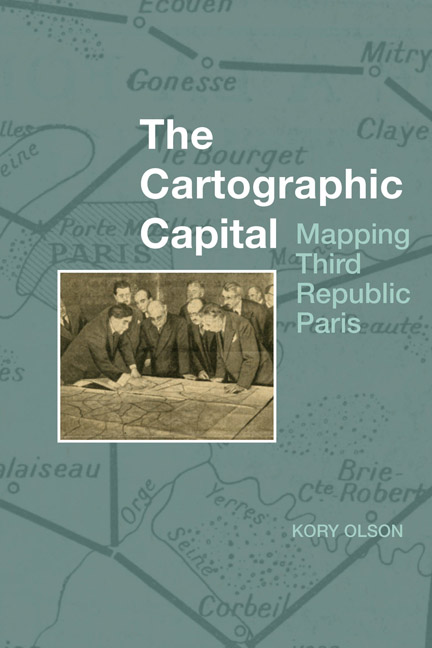Book contents
- Frontmatter
- Contents
- List of Figures
- Acknowledgements
- Introduction: Creating Republican Paris
- 1 Working with Maps
- 2 Creating Map Readers: The Rise of Geography and Cartography in Nineteenth-Century France
- 3 The Triumphant Republic: ‘Paris en 1889, les opérations de voirie exécutées entre 1871 et 1889’
- 4 A New Way of Seeing Paris: The Service Géographique's Carte de France
- 5 The Beginning of French Urbanism: Léon Jaussely's 1919 Plan d'extension
- 6 The Rise of Suburban Paris: Henri Prost's Carte générale
- Conclusion
- Bibliography
- Index
Introduction: Creating Republican Paris
- Frontmatter
- Contents
- List of Figures
- Acknowledgements
- Introduction: Creating Republican Paris
- 1 Working with Maps
- 2 Creating Map Readers: The Rise of Geography and Cartography in Nineteenth-Century France
- 3 The Triumphant Republic: ‘Paris en 1889, les opérations de voirie exécutées entre 1871 et 1889’
- 4 A New Way of Seeing Paris: The Service Géographique's Carte de France
- 5 The Beginning of French Urbanism: Léon Jaussely's 1919 Plan d'extension
- 6 The Rise of Suburban Paris: Henri Prost's Carte générale
- Conclusion
- Bibliography
- Index
Summary
Devant l'Hôtel de Ville, dans l'intervalle qui séparait l'ancienne Place du Châtelet de l'espace irrégulier qualifié Place de Grève, l'oeil était affligé par d'horribles cloaques, nommés rue de la Tannerie, de la Veille-Tannerie, de la Vannerie, de la vieille Place aux Veaux, Saint-Jérôme, de la Vieille-Lanterne, de la Tuerie, des Teinturiers, etc. Cette dernière était si peu large, que la façade vermoulue d'une des maisons, en pans de bois hourdés de plâtre, qui la bordaient, essaya vainement de s'abattre: elle ne put que s'appuyer sur celle de la maison opposée. Et quelle population habitait là!
—Baron Georges Eugène Haussmann, Mémories, Vol. III, 27–28After Louis Napoleon's term as president and his 1851 coup d’état, Paris needed his attention. The city had undergone little significant renovation in the years since the 1789 Revolution. The narrow, unlit streets as described above by Baron Haussmann were a breeding ground for crime and disease. Bourgeois Parisians had grown weary of the uprisings that prematurely terminated the Bourbon restoration and the subsequent July Monarchy, bringing in the short-lived Second Republic. By mid-century, tired of crime and revolution, the Parisian bourgeoisie pinned their hopes on Napoleon III. His promises to restore order and become ‘l’élu du commerce, de l'industrie, de la propriété’ were just what they wanted to hear. Many were tired of fearing not only for their wallets but their lives as well as they ventured into the night.
The large concentration of unhappy working-class residents in the centre of the city worried both businessman and those in power. Yet beyond crime, early Second Empire Paris had other problems. Multiple cholera epidemics hit the city in 1832 and 1849. Although primarily concentrated in the dense urban core, this disease struck everyone and everywhere, alerting Parisians of the dangers of overcrowding. The first major outbreak killed 20,000 Parisians out of a population of 861,400 (Jordan 96). In addition to crime and disease, nineteenthcentury Paris was known for having residents pour into the streets, erect barricades, and topple governments with authorities lacking the means to control them. Unable to suppress this population, leaders needed new methods for demonstrating their ability to rule over the urban space.
- Type
- Chapter
- Information
- The Cartographic CapitalMapping Third Republic Paris, 1889-1934, pp. 1 - 19Publisher: Liverpool University PressPrint publication year: 2018



